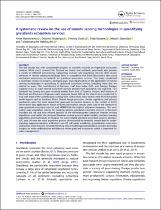| dc.description.abstract | The last decade has seen considerable progress in scientific research on vegetation ecosystem services. While much research has focused on forests and wetlands, grasslands also provide a variety of different provisioning, supporting, cultural, and regulating services. With recent advances in remote sensing technology, there is a possibility that Earth observation data could contribute extensively to research on grassland ecosystem services. This study conducted a systematic review on progress, emerging gaps, and opportunities on the application of remote sensing technologies in quantifying all grassland ecosystem services including those that are related to water. The contribution of biomass, Leaf Area Index (LAI), and Canopy Storage Capacity (CSC) as water-related ecosystem services derived from grasslands was explored. Two hundred and twenty-two peer-reviewed articles from Web of Science, Scopus, and Institute of Electrical and Electronics Engineers were analyzed. About 39% of the studies were conducted in Asia with most of the contributions coming from China while a few studies were from the global south regions such as Southern Africa. Overall, forage provision, climate regulation, and primary production were the most researched grassland ecosystem services in the context of Earth observation data applications. About 39 Earth observation sensors were used in the literature to map grassland ecosystem services and MODIS had the highest utilization frequency. The most widely used vegetation indices for mapping general grassland ecosystem services in literature included the red and near-infrared sections of the electromagnetic spectrum. Remote sensing algorithms used within the retrieved literature include process-based models, machine learning algorithms, and multivariate techniques. For water-related grassland ecosystem services, biomass, CSC, and LAI were the most prominent proxies characterized by remotely sensed data for under-standing evapotranspiration, infiltration, run-off, soil water availability, groundwater restoration and surface water balance. An understanding of such hydrological processes is crucial in providing insights on water redistribution and balance within grassland ecosystems which is important for water management. | en_US |

